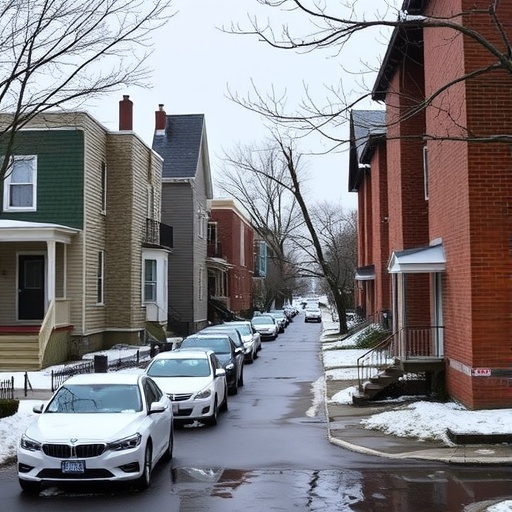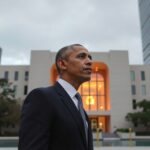In the shadow of what was once hailed as a beacon of hope, Chicago’s South Shore neighborhood is unraveling under the weight of unfulfilled promises and escalating federal interventions. Dubbed ‘Obam-a-Lago‘ by optimistic locals envisioning an Obama-era renaissance, the area surrounding the Obama Presidential Center has instead become a flashpoint for displacement fears, skyrocketing rents, and recent ICE raids that have left families terrified and community ties frayed.
From Presidential Promise to Local Heartbreak
The Obama Presidential Center, announced in 2015 as a $500 million project to revitalize Chicago’s South Shore, was meant to symbolize progress and unity. Funded primarily through private donations to the Obama Foundation, the center was slated for a 19.3-acre site in Jackson Park, donated by the City of Chicago. Proponents, including former President Barack Obama himself, touted it as a catalyst for economic growth, projecting 7,000 construction jobs and 675 permanent positions once operational.
Yet, nearly a decade later, the dream has soured for many residents. Construction delays, environmental lawsuits from groups like Protect Our Parks, and ballooning costs—now exceeding $830 million—have prolonged the agony. ‘We were told this would bring jobs and stability,’ said Maria Gonzalez, a 45-year-old single mother and longtime South Shore resident, in an interview with local reporters last week. ‘Instead, my rent has doubled since 2018, and I’m one eviction notice away from the streets.’
Statistics paint a grim picture: According to the Chicago Rehab Network, South Shore’s vacancy rate hovers at 22%, the highest in the city, while median home values have stagnated at around $150,000—far below the city average of $290,000. Gentrification pressures, exacerbated by the center’s proximity, have led to a 15% spike in property taxes over five years, per Cook County Assessor data. Speculators, eyeing the area’s potential, have snapped up foreclosed properties, flipping them at premiums that price out longtime Black and Latino families who make up 85% of the neighborhood’s 50,000 residents.
The nickname ‘Obam-a-Lago‘—a nod to the opulent Mar-a-Lago estate in Florida—started as a joke among locals but has taken on a bitter edge. What was envisioned as an inclusive legacy project now feels like an exclusive enclave, with critics arguing it prioritizes tourism over tangible community benefits. The Obama Foundation counters that over $200 million in community investments have already been committed, including workforce training programs that have placed 1,200 locals in jobs. Still, skepticism runs deep, as evidenced by a 2023 community survey by the South Shore Chamber of Commerce, where 62% of respondents felt the project has worsened housing affordability.
Housing Evictions Surge Amid Gentrification Fears
Chicago’s South Shore, a historically African American enclave dating back to the Great Migration of the early 20th century, has long battled economic decline. Once a thriving middle-class neighborhood with jazz clubs and lakefront views, it suffered from white flight in the 1960s and 1970s, followed by disinvestment that left scars of poverty and crime. The Obama Presidential Center was supposed to reverse this trajectory, but instead, it’s amplified a housing crisis that’s displacing vulnerable populations.
Eviction filings in the 60619 ZIP code, encompassing much of South Shore, jumped 28% in 2023 compared to pre-pandemic levels, according to data from the Eviction Lab at Princeton University. Landlords, anticipating an influx of visitors and higher-income workers, have aggressively raised rents—averaging $1,200 for a one-bedroom, up from $900 in 2019, per Zillow reports. Affordable housing advocates point to the loss of over 500 low-income units since 2017, many converted into luxury condos or Airbnbs.
Take the case of the Jeffery Plaza Apartments, a 200-unit complex just blocks from the center site. In 2022, owner Related Midwest—ironically, the developer behind the Obama project—announced renovations that would displace 150 families. ‘This isn’t revitalization; it’s erasure,’ protested activist Reverend Jesse Jackson during a rally outside City Hall last month. The event drew 500 attendees, chanting ‘Save South Shore’ and demanding rent control extensions.
City officials have responded with mixed measures. Mayor Brandon Johnson’s administration pledged $50 million in 2024 for affordable housing preservation, including subsidies for 300 units in South Shore. However, implementation lags: Only 20% of funds have been disbursed as of October, per a city audit. Community land trusts, like the one formed by the TrumbullPark Community Group, are gaining traction, aiming to buy and steward properties collectively. They’ve secured three buildings so far, housing 75 families at below-market rates.
Broader context reveals systemic issues. Chicago’s overall homelessness rose 12% last year, with South Shore contributing disproportionately due to its 25% poverty rate—double the city average, according to the U.S. Census Bureau. Experts like urban planner Toni Griffin from Harvard’s Graduate School of Design warn that without aggressive anti-displacement policies, Obam-a-Lago could become a symbol of inequality rather than inspiration.
ICE Raids Stoke Fear and Fracture Community Bonds
Just as housing woes simmer, recent actions by U.S. Immigration and Customs Enforcement (ICE) have poured fuel on the fire in Chicago’s South Shore. In a series of unannounced operations last week, ICE agents detained 15 individuals—mostly undocumented workers from Mexico and Central America—at local construction sites and day labor hubs. The raids, part of a national uptick under the Biden administration’s targeted enforcement, have terrified immigrant families and eroded trust in institutions once seen as allies.
‘These aren’t criminals; they’re our neighbors building the very Obama Center that’s supposed to unite us,’ said South Shore pastor Elena Ramirez, who sheltered three families post-raid at her church. The operations, which ICE justifies as focusing on ‘public safety threats,’ involved detentions for minor visa violations, sparking outrage. Protests erupted outside the Federal Building downtown, with over 300 demonstrators waving signs reading ‘ICE Out of South Shore.’
Data underscores the impact: Chicago’s immigrant population, numbering 600,000 or 21% of residents per the Migration Policy Institute, contributes $18 billion annually to the economy. In South Shore, where 18% are foreign-born, many work in low-wage sectors like construction and caregiving. The raids have led to a 40% drop in day labor turnout at hotspots like 71st Street, according to worker advocates from Arise Chicago.
Political tensions are palpable. Illinois, a sanctuary state since 2017, limits local cooperation with ICE, but federal agents operate independently. Critics, including U.S. Rep. Robin Kelly, whose district includes South Shore, blasted the actions as ‘politically motivated intimidation’ amid midterm election cycles. Kelly introduced a bill last year to expand sanctuary protections, but it stalled in Congress.
Community responses have been swift. The South Shore Working Neighborhoods Initiative, a coalition of 20 organizations, launched a rapid-response hotline for ICE sightings, fielding 50 calls in the raid’s aftermath. Legal aid from groups like the National Immigrant Justice Center has provided pro bono services to 12 detainees, with eight released on bond. Yet, the psychological toll lingers: Schools report higher absenteeism, and mental health hotlines have seen a 25% call increase from anxious parents.
This isn’t isolated; ICE arrests nationwide rose 15% in fiscal 2023, targeting non-criminal immigrants per agency reports. In South Shore, it intersects painfully with the Obam-a-Lago narrative, as many detained workers were ironically employed on center-related projects, highlighting ironies in the pursuit of progress.
Broader Political Rifts Echo National Divides
The turmoil in Chicago’s South Shore mirrors America’s deepening political fault lines, where local dreams clash with federal realities. The Obama Presidential Center, tied to a progressive icon, now stands amid debates over immigration, equity, and urban development that pit community needs against national policies.
Polls reflect the strain: A 2024 Pew Research survey found 58% of Black Americans view immigration enforcement as overly aggressive, up from 45% in 2016. In South Shore, where Democratic support remains strong—Johnson won 85% of the vote in 2023—frustrations with Biden’s immigration stance are mounting. ‘Obama promised hope, but ICE is delivering fear,’ quipped local organizer Jamal Thompson at a town hall attended by 400 residents.
Stakeholders are mobilizing. The Obama Foundation announced a $10 million equity fund in September for South Shore housing, partnering with developers to build 200 affordable units. Meanwhile, ICE has faced internal pushback; a leaked memo from the Chicago field office urged ‘community sensitivity’ post-raids, though no policy changes followed.
As the center’s 2026 opening looms, tensions could escalate. Environmental reviews continue, with a federal judge delaying permits over lakefront impact concerns. Housing advocates push for inclusionary zoning mandates, requiring 30% affordable units in new developments—a policy adopted in 15 other cities but resisted here.
Looking ahead, South Shore’s fate hinges on collaborative action. Community leaders like those from the Obama-era My Brother’s Keeper initiative are advocating for a ‘South Shore Compact,’ a blueprint integrating job training, immigrant protections, and anti-eviction measures. If successful, it could redeem Obam-a-Lago’s promise; failure risks entrenching division. With elections on the horizon and federal funding at stake, the neighborhood’s resilience will test whether hope can prevail over hardship.








